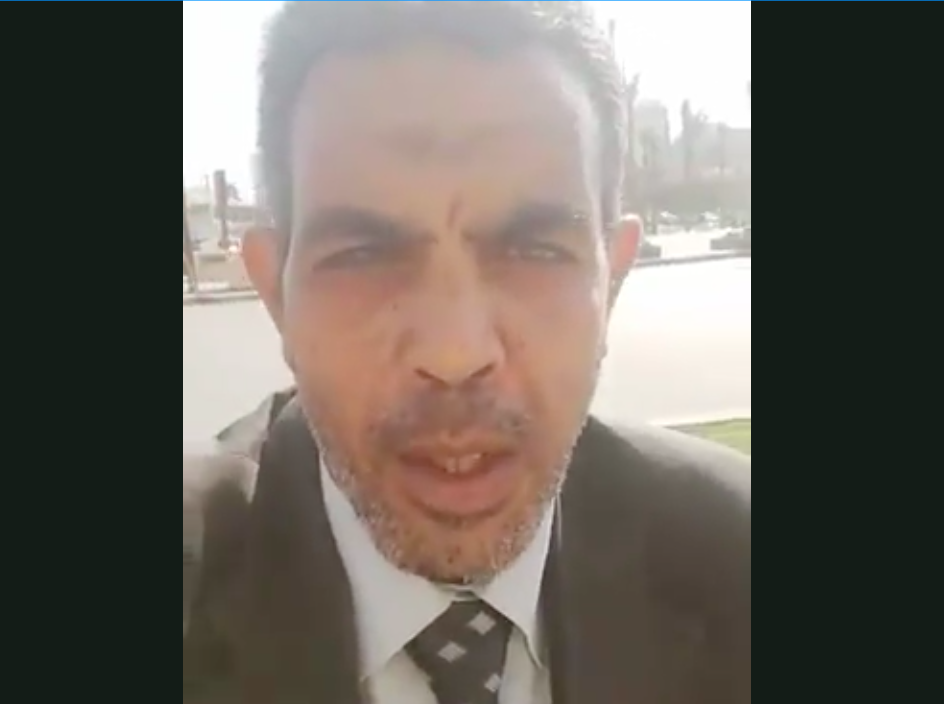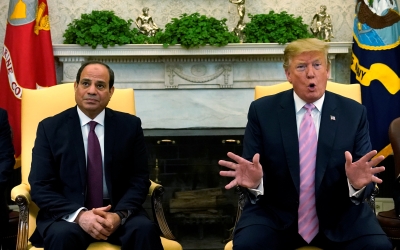Egyptian sets himself on fire in Tahrir Square to protest corruption

An Egyptian man set himself on fire in Cairo's Tahrir Square on Thursday to protest corruption and deteriorating living conditions.
In a video widely circulated on social media, the Egyptian national complained about his financial and living conditions as a result of his attempts to uncover government corruption.
The incident prompted comparisons with the 2010 self-immolation of the Tunisian street vendor Mohamed Bouazizi which was believed to be the catalyst for the Arab Spring.
In a 20-minute video broadcast on Facebook, the man, who identified himself as Mohamed Hosni, said his efforts to expose corruption by state officials saw him fired from his job at a bank and face a hefty fine at the hands of the National Security forces.
Shouting slogans against President Abdel Fattah el-Sisi's government, which he accused of being led by a "thief", the man self-immolated before policemen and passersby managed to put out the flames.
New MEE newsletter: Jerusalem Dispatch
Sign up to get the latest insights and analysis on Israel-Palestine, alongside Turkey Unpacked and other MEE newsletters
"I have nothing to cry about. My life has been ruined. I have been unjustly fired from my job and unjustly blocked from returning to it. This is what's happening now," he said shortly before setting himself ablaze.
"There's a circle of corrupt people that govern Egypt, they're all corrupt, they're all thieves… the military council is the source of the corruption in the country. They are stealing from the country until today, while people can't afford to eat.
"The masters are taking revenge on the slaves who revolted against them [in the 2011 uprisings]. This is where we are now. The more you stay silent, the worse it will get."
Tahrir Square is a plaza at the heart of Cairo and was the scene of revolutionary protests in 2011 that unseated longtime autocrat Hosni Mubarak.
According to a security source who spoke to AFP, Hosni was rescued before the blaze grew too severe.
He was rushed to hospital suffering minor burns after onlookers wrestled him down and put the blaze out, the source said.
The source further accused Hosni of being exploited by the Muslim Brotherhood. However, Hosni denied any links to the Brotherhood in his video.
He cited a protest he held in April 2013, during the rule of late President Mohamed Morsi, in which he held banners opposing Brotherhood rule.
'Those who live in exile will not liberate anyone… whoever can take to the streets to oppose an unjust ruler should do it, and I am going to do it'
- Mohamed Hosni
Prior to Thursday’s video, Hosni had posted several conversations between him and individuals opposed to Sisi’s rule. In one video, he said he was planning “a surprise that would make many people happy”.
“This country will only erupt [in protest] with a spark,” he said in one video shared on several social media platforms.
“Those who live in exile will not liberate anyone… whoever can take to the streets to oppose an unjust ruler should do it, and I am going to do it,” he said in another video.
“Stay tuned for a live stream from me from Tahrir Square. I am telling the whole world. I am Mohamed Hosni Gharib Mostafa. They know who I am, the National Security Agency and the Military Council also know me.”
Following his live video, several pro-government media including Youm7, Dostor and Al-Masry Al-Youm described Hosni as “mentally unstable” and as an ally of the Brotherhood.
They posted a video interview with his wife claiming that she has filed for divorce due to his mental instability after losing his job at an Egyptian bank. It was not clear who recorded the wife’s video, and whether she was pressured to make those statements.
Egyptian security services are often accused of recording forced confessions without due process.
Hosni has claimed that members of the Egyptian government have driven a wedge between him and his wife after his purported attempt to expose corruption. “They made her hate me,” he said in the Tahrir Square video. “They destroyed my life.”
'The Egyptian Bouazizi'
Hosni’s videos have triggered sympathy by Egyptians on social media who said he represents their economic grievances.
Under the hashtag "The Egyptian Bouazizi", activists tweeted in solidarity with Hosni, disputing claims that he is affiliated with the Brotherhood.
Sami Kamal al-Din, an Egyptian journalist and anti-government activist living in exile, posted an image of Hosni carrying a protest sign in 2013 that accused the Brotherhood of working with remnants of the Mubarak regime, implying that the accusations against Hosni are baseless.
Translation: "The Muslim Brotherhood member Mohamed Hosni sets himself on fire in Tahrir Square - this is according to Sisi's media - he also carried a banner several years ago describing the Brotherhood as corrupt, just like Mubarak's holdovers and the military."
Many of those who rose to prominence since the 2011 uprising have been imprisoned or left the country amid a crackdown on civil society and free speech under Sisi.
In the seven years since Sisi assumed power in a military coup, at least 60,000 political prisoners have languished in jail.
Economic inequality has also increased, with a 2019 World Bank report saying 60 percent of Egyptians are either "poor or vulnerable".
Middle East Eye delivers independent and unrivalled coverage and analysis of the Middle East, North Africa and beyond. To learn more about republishing this content and the associated fees, please fill out this form. More about MEE can be found here.





